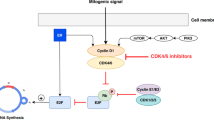Summary
Over two decades, experience with estramustine has provided limited data which support an estrogenic mechanism of action and no data which indicate the nitrogen mustard involvement in the cytotoxic properties of the drug. Consideration of the carbamate-ester portion of estramustine supports the pharmacokinetic evidence that estramustine has a long half life since enzymatic hydrolysis of the carbamate is an uncommon event. Using a variety of immunocytochemical and cellular morphology procedures, estramustine per se has been found to express anticytoskeletal properties through non-covalent binding to microtubule associated proteins (MAP's). In both fish erythrophores and in dividing human prostatic carcinoma cells, estramustine exerts an antimicrotubule effect at micromolar concentrations. Thus, estramustine possesses unique pharmacology and protein binding specificity. As such, it should not be classified as an alkylating agent. The estrogenic effects, while possibly of relevance to clinical administration, are not the primary mechanism by which the drug exerts cytotoxicity.
Similar content being viewed by others
References
Ahlgren JD, Schein PS (1983) Seminars in oncology, Vol X, No 3, Suppl 3
Aumuller G, Seitz J, Heyns W, Flickinger CJ (1984) Intracellular localization of prostatic binding protein in rat prostate by light and electron microscopic immunocytochemistry. Histochemistry 76:497–516
Cacares A, Payne MR, Binder LI, Oswald S (1983) Immunocytochemical localization of actin and microtubule associated protein MAP 2 in dendritic spines. Proc Natl Acad Sci USA 80:1738–1742
Fex H, Hogberg B, Konyves I (1984) Estramustine phosphatehistorical overview. Urology 23:4–5
Forsgren B, Bjork P, Carlstrom K, Gustafsson JA, Pusette A (1979) Purification and distribution of a major protein in rat prostate that binds estramustine, a nitrogen mustard derivative of estradiol-17β. Proc Natl Acad Sci USA 76:3149–3153
Gunnarsson PO, Andersson SB, Johansson SA, Nilsson T, Plym-Forshell G (1984) Pharmacokinetics of estramustine phosphate (Estracyt) in prostatic cancer patients. Eur J Clin Pharmacol 26:113–119
Gunnarsson PO, Forshell GP (1984) Clinical pharmacokinetics of estramustine phosphate. Urology 23:22–27
Gunnarsson PO, Forshell GP, Fritjofsson A, Norlen BJ (1981) Plasma concentrations of estramustine phosphate and its major metabolites in patients with prostatic carcinoma treated with different doses of estramustine phosphate (Estracyt). Scand J Urol Nephrol 15:201–205
Gupta RS (1986) Cross resistance of nocodazole-resistant mutants of CHO cells toward other microtubule inhibitors. Similar mode of action of benzimidazole carbamate derivatives and NSC 181928 and TN16. Mol Pharmacol 30:142–148
Hartley-Asp B (1984) Estramustine-induced mitotic arrest in two human prostatic carcinoma cell lines, DU145 and PC-3. Prostate 5:93–100
Hartley-Asp B, Gunnarsson PO (1982) Growth and cell survival following treatment with estramustine, nor-nitrogen mustard, estradiol and testosterone of a human prostatic cancer cell line (DU145). J Urol 127:818–22
Hoisaeter PA, Bakke A (1983) Estramustine phosphate (Estracyt): experimental and clinical studies in Europe. Semin Oncol 10:27–33
Kalland T, Haukaas SA (1984) Effects of diethylstilbestrol and estramustine phosphate (Estracyt) on natural killer cell activity and tumor susceptibility in male mice. Prostate 5:649–660
Kanje M, Deinum J, Wallin M, Ekstrom P, Edstrom A, Hartley Asp B (1985) Effect of estramustine phosphate on the assembly of isolated bovine brain microtubules and fast axonal transport in the frog sciatic nerve. Cancer Res 45:2234–2239
Lopez R, Karakousis CP, Didolkar MS, Holyoke ED (1978) Estramustine phosphate in the treatment of advanced malignant melanoma. Cancer Treat Rep 62:1329–1332
Muntzing J, Gunnarsson K (1984) Preclinical pharmacology and toxicology of estramustine phosphate. Urology 23:6–10
Parry EM, Danford N, Parry JM (1982) Differential staining of chromosomes and spindle and its use as an assay for determining the effect of diethylstilbestrol on cultured mammalian cells. Mutat Res 105:243–252
Sandberg AA (1983) Metabolic aspects and actions unique to Estracyt. Semin Oncol 10:3–15
Stearns ME, Jenkins DP, Tew KD (1985) Dansylated estramustine, a fluorescent probe for studies of estramustine uptake and identification of intracellular targets. Proc Natl Acad Sci USA 82:8483–8487
Stearns ME, Ochs RL (1982) A functional in vitro model for studies of intracellular motility in digitonin permeabilized erythrophores. J Cell Biol 94:727–739
Stearns ME, Tew KD (1985) Antimicrotubule effects of estramustine, an antiprostatic tumor drug. Cancer Res 45:3891–3897
Tew KD (1983) The mechanism of action of estramustine. Semin Oncol 10:21–26
Tew KD, Erickson LC, White G, Wang AL, Schein PS, Hartley-Asp B (1983) Cytotoxicity of estramustine, a steroid-nitrogen mustard derivative, through non-DNA targets. Mol Pharmacol 24:324–328
Tew KD, Hartley-Asp B (1984) Cytotoxic properties of estramustine unrelated to alkylating and steroid constituents. Urology 23:28–33
Tew KD, Woodworth A, Stearns ME (1986) Relationship of glutathione depletion and inhibition of glutathione-S-transferase activity to the antimitotic properties of estramustine. Cancer Treat Rep 70:715–720
Verbiscar AJ, Abbod LG (1970) Carbamate ester latentiation of physiologically active amines. J Med Chem 13:1176–1179
Wallin M, Deinum J, Friden B (1985) Interaction of estramustine phosphate with microtubule-associated proteins. FEBS Lett 179:289–293
Author information
Authors and Affiliations
Rights and permissions
About this article
Cite this article
Tew, K.D., Stearns, M.E. Hormone-independent, non-alkylating mechanism of cytotoxicity for estramustine. Urol. Res. 15, 155–160 (1987). https://doi.org/10.1007/BF00254428
Accepted:
Issue Date:
DOI: https://doi.org/10.1007/BF00254428




